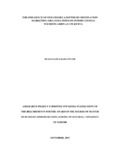| dc.description.abstract | The study investigates the relationship between the strategies adopted by destination marketing organizations and international tourists’ arrivals in Kenya. This study covers various theories that prompted the researcher’s thoughts into this research field. The study highlights literature on strategies, destination marketing and strategies and international tourists’ arrivals. The research design for this study was a descriptive survey design aimed at investigating the influence of strategies adopted by destination marketing organizations and their effect on international tourist’s arrivals in Kenya. The population of the study were three organizations namely; Kenya Tourist Board, Brand Kenya Board and the Ministry of East African Affairs, Commerce and Tourism. Due to the small size of the population a census study was conducted. The primary data was collected using a questionnaire. The respondents of the study were from the top management level and middle level management from each organization. Descriptive statistics which describe the main features of the data collected (mean, frequency, percentage) was used. The study found that the ministry of East African Affairs Commerce and Tourism is tasked with the responsibility of managing EAC and regional integration affairs, developing and promoting trade policies, promoting and marketing Kenya as a tourist destination. Several strategies have been used by Destination Marketing Organizations. These strategies include; differentiation, diversification and focused strategy. DMOs have opted for building the image of the destination; image plays a great role in international tourism. The study recommends that policy and institutional mechanisms should be initiated which promote local involvement and participation in tourism project design, implementation and management. Tourism activities in the wildlife preserves and marine ecosystems should be appropriately planned, monitored and managed to ensure that they do not conflict with conservation and sustainable use of resources. | en_US |

